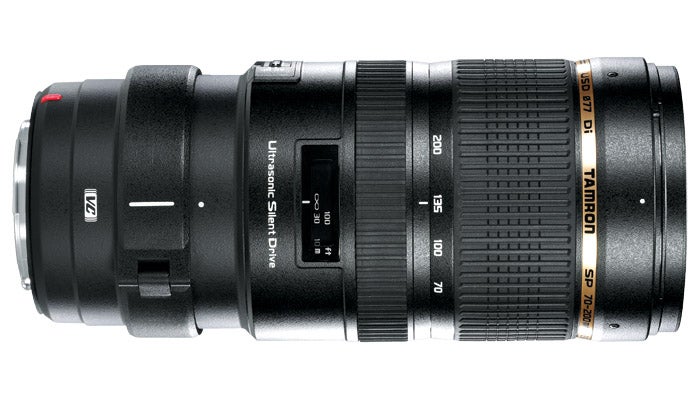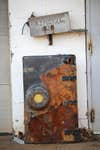Lens Test: Tamron 70-200mm f/2.8 Di VC USD
Tamron stabilizes a pro favorite

We may earn revenue from the products available on this page and participate in affiliate programs. Learn more ›
Among pros, image-stabilized 70–200mm f/2.8 full-frame zooms have become must-own glass. They’re in Canon ($2,499, street), Nikon ($2,397), Sigma ($1,399), and now Tamron’s catalogs ($1,499), and we see them at weddings, sporting events, in portrait studios, and in backpacks. Tamron’s version includes four elements of low-dispersion and one of extra low-dispersion glass. Another boast: Its Vibration Control has been redesigned for better performance.
Not for the faint of wrist, this 3.32 pounder is actually several ounces lighter and about a quarter-inch shorter than the competition. Its nonrotating front ring is nice for lens-mounted filters; the 130-degree manual focus turn is just about perfect (although at a little over a half inch, the MF ring is small); the build is robust, with rubber cowling at the lens mount. There’s no depth-of-field scale, though. (The comparable Sigma has two.)
In the field, we were bowled over by the near-silent USD focusing motor. On our Canon EOS 5D Mark III, AF was rapid, silent, and sure. On our optical test bench, the lens produced Excellent-range SQF numbers for sharpness and contrast at 70mm and 135mm. Like most zooms in this category, though, it dipped to Very Good at 200mm. (Only the Nikon held onto top sharpness at 200mm.)
In our DxO Analyzer 4.1 tests, distortion control proved best in its class: it produced only Slight distortion at 70mm and 200mm (0.11% barrel and 0.18% pincushion, respectively) and Imperceptible (0.09%) pincushioning at 135mm.
In our tests, three users averaged about 3.5 stops of additional handheld sharpness. Tempted by the nonstabilized version? It is a half-pound lighter, costs half as much, offers much more subject magnification, and takes sharper images at 200mm. But you’d miss out on a whole lot of handheld shooting. For us, money aside, it’s a no-brainer.
SPECIFICATIONS
70–200mm (68.68–196.11mm tested), f/2.8 (f/2.70 tested), 23 elements in 17 groups. Focus ring turns 130 degrees. Zoom ring turns 70 degrees. Focal length marked at 70-, 100-, 135-, and 200mm.
Diagonal view angle: 34–12 degrees.
Weight: 3.32 lbs. Filter size: 77mm.
Mounts: Canon AF, Nikon AF, Sony AF.
Included: Lenshood, tripod collar.
Street price: $1,499.
Website: tamron-usa.com
TEST RESULTS
Distortion: At 70mm, 0.11% (Slight) barrel. At 135mm, 0.09% (Imperceptible) pincushion. At 200mm, 0.18% (Slight) pincushion.
Light falloff: Gone by f/4 at three tested focal lengths.
Close-focus distance: 45.83 inches.
Maximum magnification ratio: At 70mm, 1:13.50. At 135mm, 1:8.36. At 200mm, 1:6.75.
Image Stabilization: Average of 3.5 stops for three unique users.

Back at Photokina, Tamron announced their intentions to release a new 70-200mm F/2.8 VC lens and they’ve made good on that promise. I spent some time shooting with the new lens on a fresh-out-of-the-box Canon EOS 6D. All of the images were shot in JPEG mode with standard image settings. Click the links for full-resolution images, but make sure you’re on WiFi, as the files are up to 10 MB.
Tech specs Aperture: F/2.8 Shutter Speed: 1/200 sec. Focal Length: 200mm ISO: 1600

Sadly, the birds didn’t feel like doing any flying during the 15 minutes or so I had to photograph them for a hardcore speed test, but the focusing is very quiet, which is a plus.
Tech specs Aperture: F/5.6 Shutter Speed: 1/640 sec. Focal Length: 129mm ** **ISO: 200

You can get a sense of the fine detail capabilities in the intricate rust areas.
Tech specs Aperture: F/2.8 Shutter Speed: 1/400 sec. Focal Length: 177mm ISO: 200

Shot wide open to prevent the cluttered background from becoming too distracting.
Tech specs Aperture: F/2.8 Shutter Speed: 1/640 sec Focal Length: 200 ISO: 200

The lettering on the barrels is impressively sharp.
Tech specs Aperture: F/5.6 Shutter Speed: 1/200 sec. Focal Length: 200 ISO: 200

The focus is on the plants to the left of the center of the frame.
Tech specs Aperture: F/5.6 Shutter Speed: 1/640th Focal Length: 200 ISO: 200

Tech specs Aperture: F/2.8 Shutter Speed: 1/2000 sec Focal Length: 200mm ISO: 200

We’ll have a full report on the vibration compensation in our lab test.
Tech specs Aperture: F/8 Shutter Speed: 1/160 sec. Focal Length: 200mm ISO: 200

Note that the flare was kept to a minimum and the nice circular bokeh on the specular highlight in the background.
Tech specs Aperture: F/4 Shutter Speed: 1/320 sec Focal Length: 200 ISO: 100

In this one, you can clearly see the flare happening, but I actually find it kind of appealing. The loss of contrast is a bit much, though. This was shot without the included lens hood.
Tech specs Aperture: F/4 Shutter Speed: 1/100 sec Focal Length: 117mm ISO: 100

Click the next slide to see it zoomed all the way out. The 1/80 sec. shutter speed seemed just fine thanks to the VC
Tech specs Aperture: F/8 Shutter Speed: 1/80 sec. Focal Length: 200mm ISO: 100

We’ll have to test it for sure in our lab, but it didn’t have that 70-200mm feel I’m used to. Looks like the folks over at Lensrentals found the same thing.
Tech specs Aperture: F/8 Shutter Speed: 1/80 sec. Focal Length: 70mm ISO: 100